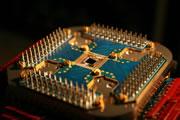 The first commercial quantum computer?D-Wave Systems Inc.
The first commercial quantum computer?D-Wave Systems Inc.A Canadian firm has built what it claims is the first fully functional quantum computer and has used it to solve a number of simple problems.
But some researchers argue that the computer isn't powerful enough to beat conventional machines, and question whether it can be scaled up to a useful size. True quantum computing, they say, is still a long way off.
D-Wave Systems, a company based in British Columbia, debuted its system on 13 February at the Computer History Museum in Mountain View, California. Although still a prototype, company officials say the machine can execute three relatively simple tasks: searching for matches in a protein database, creating a seating chart for a wedding reception, and finishing a sudoku puzzle.
“We're in a very early prototype.”
Geordie Rose
D-Wave Systems Inc.
That makes it a commercial first. But some critics say it has been oversold in the press: "Almost every popular article written on this has grotesquely over-hyped it," says Scott Aaronson, a computer scientist specializing in quantum computing at Waterloo University in Ontario, Canada. He says the machine in its current form is "completely useless from an industrial perspective".
The system is still about a hundred times slower than conventional computers, concedes Geordie Rose, chief technology officer and co-founder of D-wave. "We have a very early prototype," he says. But a computer with more qubits can be built with existing technology, and Rose believes it will be possible to scale-up the current machine into a more competitive device. Already, he says, industrial partners are eyeing the project: "We've had interest from several different parties; more than I had expected."
All at once
A conventional computer processes information in 'bits' with values of 0 and 1, but a quantum computer uses 'qubits' whose values can be 0 and 1 simultaneously. The simultaneous values in effect allow quantum machines to perform parallel computations — one of several factors that make them better than conventional set-ups.
“Even if it worked perfectly, it would be completely useless from an industrial perspective.”
Scott Aaronson
University of Waterloo
Getting a couple of qubits to interact and perform a simple logic operation was achieved in the lab some time ago. And IBM has made a 7-qubit computer1, which existed within a single molecule and was used to factor the number 15. Making a more powerful device with interacting qubits has proved to be a huge challenge.
D-Wave's computer, which features 16 qubits, takes a different approach. Its qubits consist of tiny doughnuts of current on a superconductor. The currents circulate either clockwise or anticlockwise and, left to their own devices, they will circulate both ways simultaneously — in effect giving two simultaneous 'values'.
The computer is programmed by setting the initial values of the donuts and their interactions with other donuts. The machine is then left to run, and answers are read out from the state of the final system. Unlike other systems, the qubits aren't individually controlled during the computation.
Slow progress
It should be simple to scale up this device in size because it is built using techniques similar to those found in the semiconductor industry.
ADVERTISEMENT
But to make a larger machine reliable, the company will need to control the interactions between many of qubits more precisely, says Andrew Steane, a quantum-computing expert at the University of Oxford, UK. That may prove difficult because of difficulties with control systems and general 'noise' throughout the machine. "The issue isn't how many qubits, it's how many well-controlled qubits," Steane says.
Aaronson worries that the early roll-out of D-Wave's prototype might ultimately damage the burgeoning field of quantum computing. "If it fizzles out," he says, "people might say that quantum computing as a whole is just bunk."
Visit our computingat16qubits.html">newsblog to read and post comments about this story.
D-Wave Systems Inc.
University of Waterloo
